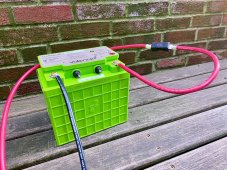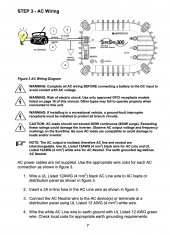reg
Winter: New York City Summer: Atlantic Canada
- Joined
- Mar 24, 2021
- Messages
- 336
A couple of personal lessons...
I'm driving out to West Marine in Port Washington today to get the battery cables made. I should have gotten on the phone to local suppliers in the first place. Instead, I spent a good amount of time trying, unsuccessfully, to organise battery cables over the internet, and ultimately from a supplier on the other side of the continent.
Not only that, but West Marine's own website turned out to be misleading. I learned that by picking up my phone and calling its nearest brick and mortar store - where I spoke with an actual human being who not only solved my problem, but comes from the same mold as the semi-retired guys and ladies who work at L.L. Bean's original store in Freeport, Maine and Lee Valley Tools's flagship store in Ottawa, Canada. Knowledgeable, a bit of a character, solved my problem.
This experience has also reinforced a lesson that I learned a few years ago. For electrical components, I start with manufacturers' sites and specialist suppliers like McMaster-Carr, Mouser Electronics and Newark. For all its strengths, Amazon is a generalist retailer. Its selection, when it comes to electrical components, is limited. Had I not spent some time on Littelfuse's site, I would never have known that its in-line MIDI fuse holder existed. Instead of spending $9 at Newark, I could well have wound up spending $53 on a Blue Sea holder and fuses on Amazon - an offering that is not only ridiculously priced, but is overbuilt to the point of defeating Littelfuse's reasons for creating the MIDI format. On some of the components that I wanted, if I could even find them on Amazon, delivery was from the other side of the Pacific Ocean and weeks away.
The only downside to visiting Port Washington today is that I live in the gridlock capital of the world. The 20mi/32km drive will take an hour, minimum. But I've got a lunch of Blue Point oysters (hey, it's still an "R" month) and Long Island clams to look forward to.
One tip. Don't start a call to West Marine the way that I did. I told the person who answered the phone that I wanted to speak with someone about Ancor cable. This led to an unanticipated, but entirely sensible question: "What kind of anchor do you need a cable for?"
I'm driving out to West Marine in Port Washington today to get the battery cables made. I should have gotten on the phone to local suppliers in the first place. Instead, I spent a good amount of time trying, unsuccessfully, to organise battery cables over the internet, and ultimately from a supplier on the other side of the continent.
Not only that, but West Marine's own website turned out to be misleading. I learned that by picking up my phone and calling its nearest brick and mortar store - where I spoke with an actual human being who not only solved my problem, but comes from the same mold as the semi-retired guys and ladies who work at L.L. Bean's original store in Freeport, Maine and Lee Valley Tools's flagship store in Ottawa, Canada. Knowledgeable, a bit of a character, solved my problem.
This experience has also reinforced a lesson that I learned a few years ago. For electrical components, I start with manufacturers' sites and specialist suppliers like McMaster-Carr, Mouser Electronics and Newark. For all its strengths, Amazon is a generalist retailer. Its selection, when it comes to electrical components, is limited. Had I not spent some time on Littelfuse's site, I would never have known that its in-line MIDI fuse holder existed. Instead of spending $9 at Newark, I could well have wound up spending $53 on a Blue Sea holder and fuses on Amazon - an offering that is not only ridiculously priced, but is overbuilt to the point of defeating Littelfuse's reasons for creating the MIDI format. On some of the components that I wanted, if I could even find them on Amazon, delivery was from the other side of the Pacific Ocean and weeks away.
The only downside to visiting Port Washington today is that I live in the gridlock capital of the world. The 20mi/32km drive will take an hour, minimum. But I've got a lunch of Blue Point oysters (hey, it's still an "R" month) and Long Island clams to look forward to.
One tip. Don't start a call to West Marine the way that I did. I told the person who answered the phone that I wanted to speak with someone about Ancor cable. This led to an unanticipated, but entirely sensible question: "What kind of anchor do you need a cable for?"
Last edited:








